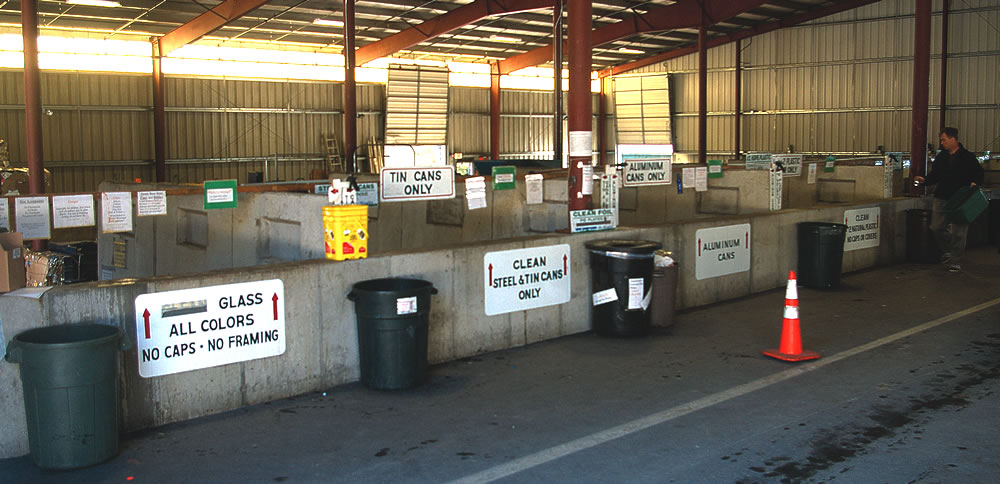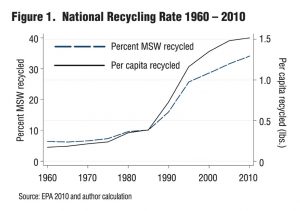Survey data shows households prefer transporting recyclables to the transfer station and sorting them there, and favor programs that increase the community recycling rate.
Christopher Wright and John M. Halstead
BioCycle April 2013, Vol. 54, No. 4, p. 40

The typical rural community in New England has community transfer stations where there is no curbside recycling or trash collection. Households bring their recyclables to dropoff centers where they sort them by material.
The number of municipalities using a form of MSW user fees, e.g., Pay-as-you-throw (PAYT), to address costs increased from 5,200 communities in 2001 to 7,100 in 2006 (Skumatz and Freeman, 2006). These programs are credited with reducing MSW generation by 18 to 60 percent for communities adopting them. In New Hampshire, 47 towns were using PAYT as of 2010. Concurrently, recycling in the U.S. has increased as the number of municipalities in the U.S. providing community recycling programs grew from 2,886 in 1990 to 8,660 in 2006. There were an estimated 12,700 community drop-off centers collecting residential recyclable materials in 1997 (USEPA, 2003; Center for Sustainable Systems, 2009); a more recent report found 68 percent of the U.S. population has access to community drop-off recycling programs (American Forest and Paper Association, 2010). Figure 1 shows the trend in the national recycling rate for the period 1960 to 2010.
However, the rate of growth in the national recycling rate has declined over the past 10 years. To increase recycling, many states and municipalities are establishing new goals for recycling rates. For example, the states of California and Florida recently enacted legislative initiatives to increase their statewide recycling rate from 39 percent to 75 percent by 2020. To increase recycling and reduce costs, single-stream recycling has been increasingly adopted by communities across the country. Single stream is a collection and processing system in which all designated recyclable materials (paper, metal, plastic and glass containers) are commingled in one collection container. Sorting and processing of recyclables is conducted at a materials recovery facility (MRF). The potential reduced costs generated by single stream are attributed to automated collection and sorting, use of larger collection bins, and use of single-compartment compaction trucks to collect and transport recyclables. Concerns have been noted about single stream in that while it may reduce collection costs, these savings may be more than offset by increased processing costs and revenue decreases due to material losses (Eureka, 2002; Byars, 2012; Lantz, 2008). Single stream recycling has grown considerably in the past decade; AFPA (2010) notes that the availability of single-stream services in communities that recycle more than doubled between 2005 and 2010.
Community Survey
Many communities in New England are considering adoption of single-stream recycling. However, questions remain as to how the system will work in rural vs. urban areas (where the majority of single stream programs have been implemented), curbside vs. dropoff towns, and how residents will view a change from the systems with which they have become comfortable. The University of New Hampshire Department of Natural Resources and the Environment decided to survey several towns that are typical of rural New England, i.e., they have community transfer stations, low population density, and no curbside recycling or trash collection. The towns of Lee, Nottingham, and Northwood in southern New Hampshire were selected because of the similarities in their solid waste disposal and recycling services. Each town has mandatory recycling ordinances, and relies on property tax revenues for operating, transportation and disposal costs. Recyclables are sorted by material.
The mail survey, conducted in February and March 2012, consisted of 400 residential property owners in each town. Respondents were informed of their town’s total annual expenditure and average monthly cost per household for trash and recycling services, the town’s landfill disposal cost per ton of solid waste, the town’s annual community recycling rate, the prior year’s savings from reduced disposal cost attributed to removal of recyclables from the waste stream, and the revenue from the sale of recyclable materials. The survey examined each household’s trash and recycling practices, respondent’s familiarity and frequency of use of the town’s MSW and recycling services, the household’s level of recycling by material, environmental attitudes, and the determinants of households’ willingness to pay to dispose of trash to support community recycling services. The survey also examined household preferences for switching from their current level of recycling services which require multiple sorting of recyclable materials, to single-stream recycling.
Of the 1,200 mailed surveys, 522 were returned for a response rate of 43.5 percent. While this response rate is comparable to current mail surveys, the issue of biased results (due to nearly 57 percent of respondents not completing the survey) must be kept in mind. Sample respondents were older with more formal education than the average town resident; males were overrepresented in the sample. Seventy eight percent of respondents take their trash to the town’s transfer station, and 82 percent transport their recyclables to the drop-off facility. About 12 percent pay a private company to collect their household trash. Fifty-five percent of respondents dispose their trash once a week and 23 percent dispose their trash every two weeks. Twenty-two households (4 percent) did not recycle. Of those who do recycle, 70 percent of households self-report they recycle 50 percent or more of paper materials (newspaper, paper, cardboard), and 75 percent or more of metal and plastic containers. One-third of respondents compost their food waste. Many respondents were apparently quite enthusiastic about the topic, as more than a quarter provided detailed opinions and suggestions on the section provided for additional comments.
The strongest pro environmental attitude was associated with the statement, “Humans are abusing the environment,” with 86 percent of respondents agreeing with the statement. Fifty-two percent disagreed with the statement, “Global climate change has been exaggerated,” 35 percent agreed, and 13 percent were unsure. The largest uncertainty is associated with the statement, “Human advancement will ensure that the earth is always a livable place,” with 35 percent of respondents indicating they are unsure. Fifty-five percent of the respondents were categorized as pro environment based upon their responses. General comments supported these numbers, although some respondents questioned both the economic and environmental net benefits of recycling.
To Single Stream Or Not To Single Stream
Regarding the key question of changing recycling and other waste management systems, respondents displayed a preference for the status quo, i.e., their current level of services relative to any proposed alternative programs (again, with notable exceptions by those who voiced concerns with the current logistics of recycling). Fifty five percent of respondents favor the current sorting system, with 45 percent favoring single-stream services. It would be useful to examine household opinions on single-stream recycling after a program has been implemented and households have adjusted to it.
Some respondents emphasized in their comments that their community should be left alone and strongly communicated they did not want any interference from “outside” interests (as one respondent put it, “it seems we aren’t broken”). They were concerned the survey results may be used to promote changes to trash and recycling services they did not want (in spite of specific survey language to the contrary). It may also be relevant that 59 percent of respondents strongly agreed or agreed (as compared to 18 percent who disagreed or strongly disagreed) with the statement, “it is important that we control our recyclables,” since adopting single stream programs often involves hiring an outside firm to handle the recycling operations of the town.
Analysis of the “status quo” variable indicates households associate a reduction in satisfaction with adoption of alternative programs relative to the current community’s trash and recycling services. This result makes sense given that 73 percent of households are very satisfied or satisfied with their community’s trash disposal services, and 77 percent of households are very satisfied or satisfied with community recycling services. Social issues were also noted in the comments sections. Involving the whole family in the recycling/waste management process, educational opportunities, interacting with neighbors, and visiting the swap shop were all cited as advantages of the current system. One household noted that having weathered the depression, reusing items was second nature and provided additional use from items that have “supposedly reached the end of the trail.”
Statistical analysis of respondents’ willingness to pay to switch from their current recycling program to single stream found that respondents who expect to recycle more with single stream are willing to pay $1.31/month more than respondents who were uncertain of the effects of adoption. Respondents who are categorized as pro environment are willing to pay $1.41/month more than respondent’s without pro environment attitudes to switch to single stream. Overall, though, respondents had a negative willingness to pay $1.13/month to adopt single stream (that is, they would need to be paid to adopt the program); in other words, on average, adoption of single stream was perceived to make them worse off than the status quo. These results are consistent with previous studies which have shown reluctance to switch from current recycling programs to single-stream recycling in Madison, Wisconsin (Jamelske and Kipperberg, 2006) and Seattle (Kipperberg and Larson, 2010). Comments on our survey forms noted that some would pay additional fees if the level of service increased, while others were concerned with increased litter or overcompacted bags that might result from PAYT.
Summary And Implications
The motivation for this study was to identify the factors influencing a household’s willingness to pay for a proposed change to their municipal trash and recycling services. Results suggest households on average are somewhat reluctant to switch to single stream. These results are consistent with those found elsewhere. The many and detailed comments from survey respondents indicate a high level of interest in the topic (realizing, of course, that the most passionate individuals — pro and con — in a survey pool are the ones who tend to respond in the first place!).
Statistical analyses suggest households prefer transporting their recyclables to the transfer station and sorting their recyclables, and favor programs that increase the community recycling rate. Respondents with higher levels of education, who are not satisfied with current recycling services, and who expect to increase their level of recycling with the single-stream options, show more enthusiasm for switching from the status quo level of services.
Only 23 percent of households in the three survey towns prefer curbside trash collection, 34 percent prefer curbside recycling collection, 45 percent prefer less sorting and 55 percent prefer more sorting of recyclables; 72 percent prefer programs that increase the community recycling rate. A number of respondents noted that their driveways were so long it would be more trouble to haul the containers back and forth than go to the transfer station. Only 17 percent of respondents prefer changing from their community’s current level of trash and recycling services. It seems clear that any proposed changes to current services may be positively received if households are confident the change will result in increasing their community’s recycling rate.
Approximately 75 percent of respondents are either very satisfied or satisfied with their community’s trash and recycling services. Households in this study expect to actually be worse off if their town implemented either curbside collection of trash or recyclables, or implemented single-stream recycling. Households display strong preference for their community’s current level of trash and recycling services.
Conclusions
All else equal, respondents with pro environmental attitudes who regularly practice “green” consumption behavior are willing to pay more for disposing trash or switching to single-stream recycling compared to respondents without a pro environment attitude and who do not display green consumption behavior. On average, households have a negative opinion about implementing curbside collection of household trash and recyclables, and a positive opinion about increasing the sorting requirements for recyclables. This preference for sorting recyclables is described in the respondent’s comments that characterize sorting recyclables as educational for children, and as a way for households to become aware of their waste generation.
The benefits of single-stream recycling may have differential impacts depending on type of collection mode. One reason communities with curbside collection of recyclables have adopted single-stream recycling is the cost savings associated with collection when all recyclables are commingled and collected and transported in one container. For communities providing trash disposal and recycling services at a central drop-off facility, the benefit of single-stream collection to the town may be marginal, and based upon results from this study, implementation of single-stream recycling on average decreases household well-being. Additional survey work is needed to assess citizens’ opinions in communities where single stream has been adopted.
Christopher Wright is Instructor, Department of Economics, University of Alaska-Fairbanks, and John Halstead is Professor, Department of Natural Resources and the Environment, University of New Hampshire, Durham. Partial funding for this research was provided by the New Hampshire Agricultural Experiment Station. This is scientific Contribution Number 2504. The authors gratefully acknowledge the town officials and survey respondents who made this analysis possible.
References
AFPA (American Forest and Paper Association). 2010. Community Survey Executive Summary. http://www.paperrecycles.org/news/2012/12/03/2013-american-forest-paper-association-recycling-awards-call-for-entries.
Byars, Steven A. 2012. “Single-stream Versus Dual Stream Recycling Management: Do the benefits justify the means?” Waste Age, Oct. 17.
Center for Sustainable Systems. 2009. “Municipal Solid Waste Facts Sheet,” Ann Arbor: University of Michigan.
Eureka Recycling. 2002. A Comparative Analysis of Applied Recycling Collection Methods in St. Paul. Eureka Recycling, St. Paul, Minnesota.
Jamelske, Eric, and Grom Kipperberg. 2006. “A Contingent Valuation Study and Benefit Cost Analysis of the Switch to Automated Collection of Solid Waste with Single Stream Recycling in Madison, Wisconsin.” Public Works Management and Policy, 11(2), 89-103.
Kipperberg, Gorm, and Douglas Larson. 2010. “Heterogeneous Preferences for Community Recycling Programs,” UiS Working Papers in Economics and Finance http://ideas.repec.org/s/hhs/
stavef.html. University of Stavanger, Norway.
Lantz, Daniel. 2008. “Do the advantages of single-stream recycling hold up in a head-to-head comparison? An examination of several single-stream and dual-stream programs tell the tale. Resource Recycling. December.
Skumatz, Lisa A., and David J. Freeman. 2006. “Pay as You Throw (Payt) in the Us: 2006 Update and Analysis,” Superior, Colorado: Skumatz Economic Research Associates, 27.
USEPA. 2003. “Municipal Solid Waste Generation, Recycling, and Disposal in the United States: Facts and Figures for 2002,” United States Environmental Protection Agency, 10.
USEPA. 2011. “Municipal Solid Waste Generation, Recycling, and Disposal in the United States: Facts and Figures for 2010,” United States Environmental Protection Agency, 11.











